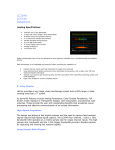Download Six-Step Troubleshooting Plan
Transcript
Section 4 Six-Step Troubleshooting Plan Learning Objectives: 1. Introduce the six−step troubleshooting process. 2. Explain what needs to be done when verifying a problem. 3. Explain all the components of a related symptoms check. 4. Using the circuit tracing technique, show how to analyze the symptoms and define the problem you need to diagnose. 5. Show how to use the EWD when isolating a problem. 6. Explain repair techniques for wires, terminals, and connectors. 7. Perform a practice case study on the Lexus Body Electrical Simulator using the six−step approach. Body Electrical Diagnosis - Course L652 1 Section 4 2 LEXUS Technical Training Six-Step Troubleshooting Plan Introduction You have now covered all of the tools" used when diagnosing electrical problems: • Basic electrical concepts • Use of the EWD • Tracing current flow through a system circuit diagram • Use of the DVOM & jumper wires Now it’s time to put all of these components together to diagnose electrical problems. The Diagnostic Process It would be great if we could just walk up to a vehicle and instinctively know where an electrical problem was, and what exactly had to be done to repair it. This happens occasionally when fixing a problem that you have seen a number of times on a particular model. Your experience from repeatedly fixing this problem allows you to make the repairs quickly, with no wasted effort. But what about problems that you see on only an occasional basis, where there is no trend" of past failures to help you? To diagnose these types of problems in the least amount of time, you need to make your diagnosis following a six−step troubleshooting plan. Six-Step Troubleshooting Plan In L623, the Six−Step Troubleshooting Plan was introduced. These steps are: 1. Verify the complaint 2. Determine the related symptoms 3. Analyze the symptoms 4. Isolate the trouble 5. Correct the trouble 6. Check for proper operation By using this troubleshooting plan, you can minimize the amount of time spent diagnosing the circuit by performing only the checks that you need to make, with an emphasis on checks that are the easiest to make. Quickly finding and fixing an electrical problem doesn’t depend on luck, but on your skills: applying what you know about circuits, using the EWD, and devising a strategy to isolate the location of the problem. The six−step approach is a way to organize your efforts, keeping you on−track while you are troubleshooting the problem. Body Electrical Diagnosis - Course L652 3 Section 4 Six-Step Troubleshooting Plan 4 LEXUS Technical Training Six-Step Troubleshooting Plan Step #1: Verify the Complaint This is the first step in any diagnostic process. When you are handed a repair order with a customer’s complaint on it, there are three things that you must do: 1. You must be able to identify the problem the customer noted 2. You must determine if it is a problem or not 3. If there is a problem, determine if it is intermittent or continuous Identify the The average customer is not a technically oriented" person. When they Problem describe a problem, it’s not always going to be easy to understand them, especially if you weren’t the person who wrote it on the RO. Your knowledge about how each system works is very important in recognizing what the customer is talking about. If you don’t know how a system is supposed to operate when it’s OK, you won’t know when it is broken. Because of the number of systems/circuits on the vehicle and the increased use of ECU−type controls in them, it is becoming more difficult to keep up with the details on how all the systems, model to model, operate. The best places to look for information on how a system should operate are the System Outline in the EWD and the Owner’s Manual. Verify the Complaint Body Electrical Diagnosis - Course L652 5 Section 4 Does a Problem Sometimes what seems like a problem to a customer is actually a Exist? normal function of the circuit. For example, the customer complaint could be about the power door locks: When the key is in the ignition, with the door open, the power door locks won’t lock." A condition such as this is not a problem, but a normal function of the Power Door Lock ECU and its key confine" feature which is designed to prevent the customer from locking their keys in the car. For the customer, information about the operation on all the electrical systems on the vehicle can be found in the Owner’s Manual. For you, detailed information about the operation of different electrical systems can be found in the EWD, as well as in the Repair Manual Body Electrical section. There are also instances where the customer is noticing a characteristic of the vehicle. There are no fixes" for these non−problems. The best way to identify this type of condition is to compare the customer’s vehicle to a known good vehicle. Use the Owner’s Manual as a Reference Like the EWD system outline, the Owner’s Manual is a good resource for information on how different systems or circuits are supposed to operate. 6 LEXUS Technical Training Six-Step Troubleshooting Plan Intermittent or When verifying the problem, you must also determine if the problem is Continuous? continuous or intermittent. If the problem is continuous (or not inter− mittent), it should be fairly obvious when you operate the suspect system. Intermittent problems can be more difficult to find. If the problem is intermittent, you’ll need to know as much information as possible (from the ASM or customer directly) about the conditions that were present when the problem occurred for the customer. For example, electrical problems can be triggered by ambient temperature, vibrations from road conditions, weather, or the type of driving (only on turns, hills, etc.) How the customer actually operates the system can also be a factor. If the conditions are repeated and the problem does not re−occur, make a thorough visual inspection of the harness, connectors, and terminals, with attention to the terminal spread. Simulate the vibrations that are caused during driving by wiggling" harnesses and connectors. Keep in mind that as you move the harnesses or disconnect connectors, you may cause the problem to temporarily fix" itself. While making your inspections, try to minimize these changes" to the circuit, and keep track of which harnesses or connectors you have disconnected or moved. Although it will be difficult in some cases, be sure to identify exactly what is causing the problem, and NEVER consider the vehicle’s problem solved if it happens to magically fix itself". Intermittent Problem Simulation Try to simulate the conditions under which the problem occurred. The ES 300 Repair Manual, has a Troubleshooting Section which was introduced to assist in diagnosing problems with ECU controlled systems. Body Electrical Diagnosis - Course L652 7 Section 4 In general, you cannot make an accurate diagnosis or repair of a problem you cannot duplicate. If the situation warrants it, call Technical Assistance to see if there have been any other reported cases of the problem or for advice on how to proceed with the vehicle. Step #2: Determine the Related Symptoms Now that you have verified that there is a problem, you need to examine the problem symptoms more thoroughly. The related symptoms check is basically an operational check, so you won’t need any tools except for the EWD. The major goal of this check is to determine: 1. How much of the circuit is affected. 2. Find clues to the location of the problem by operating other circuits related or connected to the problem area. To say determine the related symptoms" sounds complex, but this is one of the most important and time saving steps you can make in the diagnostic process. How a Circuit is In this step, you need to operate the problem circuit thoroughly, noting “Related” exactly what is and what is not working. Based upon your observations, make checks to the related circuits. Circuits are related to another circuit because of a parallel connection: • Most electrical circuits consist of two or more loads that are connected in parallel. • Entirely different circuits are related to another circuit by a parallel connection to common power sources (fuses) or ground points. • Shared sensor or switch functions in which a single switch operates a number of different circuits (such as the LH front door courtesy switch operating both the interior lighting and key warning buzzer circuits). 8 LEXUS Technical Training Six-Step Troubleshooting Plan How Circuits are Related Circuits are related through shared fuse/power connections, and through splices on the +B or ground side of the component. Body Electrical Diagnosis - Course L652 9 Section 4 How Much of In order to know what loads or other circuits are related, you’ll need to the Circuit is look in the EWD System Circuit Diagram. The wiring diagram will tell Affected? you what loads are connected in a particular circuit, and how they are switched. Section H Power Source (Current Flow Chart), as well as the power source system diagram, will give you +B side" circuit information. For ground point information, Section J diagrams all of the splices on the ground side of the circuits. By checking the operation of related circuits, you will be eliminating parts of the circuit or components as the possible problem causes. With fewer items that need to be checked, you’ll spend less time isolating the location of the problem. While operating the circuit, you need to determine if the problem affects all of the circuit or just part of it. Based upon how the circuit operates, you can make some assumptions: If Entire Circuit is If the entire circuit system is dead", this indicates that: Inoperative • There is a possible problem with a power (fuse) or ground circuit. • The load or component is bad. There are a large number of problems that could cause a component not to work, from an open power wire or ground wire, to a simple bad component. Because of this, you need a place to start your inspection. To begin, the easiest inspection to make would be to check the power and ground of the component by operating related circuits. By using the EWD, making a quick check of both power and ground is simple: • Checking Power: Look at the system circuit diagram and Section H, Power Source Current Flow Chart to determine other circuits which share the fuse and check their operation. Even if the fuse is not shared by another circuit, simply locating and inspecting the fuse can be done quickly. • Checking Ground: Operating a shared" circuit also provides a quick check of the ground circuit. By using the Section J, Ground Point information in the EWD, you can find out if another circuit uses the same ground point. If a circuit which shares the ground works OK, you’ll know that the ground point is OK. Neither of these checks isolates the exact location of the circuit problem. But they can quickly point to the areas you need to check and save you from making a lot of unnecessary inspections. 10 LEXUS Technical Training Six-Step Troubleshooting Plan Check for Possible Fuse or Ground Problem If the whole circuit is inoperative, operate another circuit which uses the same fuse. Then operate another circuit that uses the same ground point. Body Electrical Diagnosis - Course L652 11 Section 4 If Any Part of the If any part of the circuit still works: Circuit Works • You know that the power to the circuit and the main ground point are probably OK. • You need to find out exactly which loads are working and which are not. This will let you look for common wiring or connections between the bad" parts of the circuit. If any part of the problem circuit works, it is extremely important to determine exactly which parts are working and which parts are not. This step will save you from making unnecessary checks to parts of the circuit that are OK. For example, the customer complaint is that the stop lights do not work. As you step on the brake, you notice that the high mount stop light works. Knowing this verifies that a large portion of the circuit is OK. By eliminating parts of the circuit that are OK, the number of places you need to check is reduced. This is what checking the related symptoms is all about. 12 LEXUS Technical Training Six-Step Troubleshooting Plan Eliminate Parts of the Circuit If one or more of the stop lights work, you know that the fuse , the grounds, and part of the wiring are OK. Body Electrical Diagnosis - Course L652 13 Section 4 Circuits with When working on a system that has self−diagnostic capability, the Self-Diagnostics New Car Features (NCF) book and the Repair Manual (RM) are the only places to find information about how to access the Diagnostic Trouble Codes, and what each individual code means. The RM also contains specific diagnostic procedures for each circuit, including a table to direct you in diagnosing problems that do not set trouble codes. Because the method for accessing the codes varies from system to system, you’ll need to turn to the specific RM section for each of these systems. In these circuits, the EWD is best used in conjunction with the RM and NCF. It’s location tables and color wiring diagrams provide a good supplement to the RM information. Use the Repair Manual for Systems with Self-Diagnostics The RM is the first place to look when working with these systems. The EWD is helpful, especially with the color wiring diagrams, and location information. 14 LEXUS Technical Training Six-Step Troubleshooting Plan Diagnosing If the circuit has an ECU with self−diagnostic ability, the general with DTCs diagnostic strategy is to: 1. Always check for Diagnostic Trouble Codes (DTC) first, and write them down. Point any Freeze Frame data for reference. 2. Clear the code memory and operate the system/vehicle to see if the problem is intermittent or continuous. 3. If the trouble code(s) reappear, follow the diagnostic tables in the RM. 4. If there are no codes, but there is a problem present, use the Problem Symptoms Table in the repair manual to direct you to the proper inspections. 5. While diagnosing the circuit, use the EWD to help you locate the components, pins, connectors, or splices. There are other techniques that you can use depending on the system you are diagnosing. This additional information on ECU system diagnosis is covered in L672. Diagnostic Trouble Codes (DTCs) DTCs are used in many body electrical systems including Cruise Control, Anti-lock Brakes, Airbag, and Engine Control Systems Body Electrical Diagnosis - Course L652 15 Section 4 Step #3: Analyze the Symptoms In order to fix the problem, you need to know exactly what problem you’re dealing with. When verifying the problem, you were able to get a better understanding of the customer’s complaint. After making the related symptoms checks, you may have found other circuits that are or are not affected. At this point, you need to stop, and put all of this information together to specifically define: • Exactly which components/circuits are affected (both the customer’s complaint and any related symptoms) • What kind of problem you need to look for (open, short−to−ground, high resistance, feedback) • When it occurs (what operating conditions: key ON, driver’s door open, etc.) After doing this, go to the System Circuit Diagram (or a photocopy of the diagram if possible), and trace the current flow paths in the parts of the circuit that are confirmed as working. By tracing the current flow paths, you will have a visual reference of areas of the circuit you don’t need to check. Areas that you have NOT traced are all places that a possible problem could exist. All of this up−front work will have a payoff: Less time spent making checks on the car! 16 LEXUS Technical Training Six-Step Troubleshooting Plan Trace the Paths of Current Flow The shaded areas indicate where the circuit is OK. Tracing current flow here is the same as you did earlier in the course. Body Electrical Diagnosis - Course L652 17 Section 4 Step #4: Isolate the Problem To isolate the problem, there are three actions you need to make: 1. Onthewiringdiagram,findtheareasthatarepossibleproblemareas 2. Determine where to begin making the checks 3. Make your inspections. Find the Possible When analyzing the symptoms in step 4, you traced the paths of Problem Areas current flow in the parts of the circuit that were good". You’ll now see sections of the circuit that have NO tracing on it, places where there is NO confirmed current flow. Anywhere you have not traced current flow is a potential problem area. If you are working with a photocopy of the diagram, circle all of the locations where the problem could possibly be. This gives you a good visual reference as to the places you’ll potentially need to check. Where to Begin Since any ONE of these locations you circled could be the cause of the problem, you’ll need to find a place to start. In general, the order you should inspect the potential problems is based upon: • How easy it is to get to the component • If the inspection can be done visually • If there is a known history of failures at a particular point • If multiple components/circuits are inoperative: Start with parts of the circuit that are common to both (as opposed to looking for 2 separate problems). The inspection process involves the use of all of the tools we discussed in Section 3 (visual, DVOM, or jumper wire). Make a mental plan of at least the first two initial checks you need to make. If these initial checks do not find the cause of the problem, they will at least lead you into making the additional checks to the circuit which will isolate the problem. Remember that the location of the problem will be in one of the areas you circled on the wiring diagram. The Split-Half If the accessibility of the circuit is good, you can also apply the split−half Method method. Applying the split−half method to the wiring diagram, you would locate the middle of the bad" part of the circuit. After you find the connector nearest to that point, you would determine which half (+B side or ground side) of the circuit is bad" by making an open circuit voltage or continuity check. Once that is determined, you would go to a connection in the middle of that bad" section of the circuit, and again determine which half of the circuit has a problem. You continue to split the problem section of the circuit in half, until the actual problem is isolated. 18 LEXUS Technical Training Six-Step Troubleshooting Plan NOTE Whether you apply the split−half method to isolate the problem, or simply follow the System Circuit Schematic, checking the items that are most accessible first, you are still applying a process of elimination. And that really is the heart of the diagnostic process. There are specific techniques that you can use to isolate open circuits, short−to−grounds, parasitic loads, and high resistance problems. These techniques will be discussed in Section 5 of this handbook. Body Electrical Diagnosis - Course L652 19 Section 4 Circle the Possible Problem Areas Since the problem affects both bulbs, you would concentrate on the area that is in parallel to both. You could still have more than one problem which affect each bulb separately, but the odds would be in your favor. 20 LEXUS Technical Training Six-Step Troubleshooting Plan Where to Start Your Diagnosis Use the component location information in the EWD to determine where to make your inspections, and which is the easiest to get to. Body Electrical Diagnosis - Course L652 21 Section 4 Step #5: Correct the Trouble Correcting the trouble is probably the most straightforward step in the diagnostic process. Making the repair to an electrical problem will always involve: • Repair or replacement of a component • Wiring repair • Service to a circuit connection • Connectors • Terminals • Ground point Component Service Hints • When disconnecting and replacing components, make sure that the circuit is off or the battery is disconnected. • Certain circuits require special handling. The air bag system for example requires you to disconnect the battery and wait up to 90 seconds before servicing the system. Always refer to the Repair Manual for special service precautions. • If the battery needs to be disconnected, write down the customer’s radio station pre−sets". Reprogram the stations and reset the clock after reconnecting the battery. Wire Repair For any wiring, connector, or terminal repair, your best resource is the Lexus Wire Harness Repair SST (p/n 00002−04201−02). This kit contains an assortment of replacement terminals, wire, tools, and supplies that you will need to perform wire harness repairs. Also, the wire repair manual, provided with the kit, has charts for terminal and connector ID/part numbers, and complete instructions on how to make wire, terminal, and connector repairs. HINT • Cuts in the insulation should be wrapped with silicon tape (supplied in the Wire Repair SST) or covered with heat−shrink tubing. Be sure to overlap the repair by about 1/2 inch on either side. • If the damaged wire needs replacement, make sure the same or larger diameter is used. Also, try to use the same wire color. When removing the wire insulation, be careful not to break or nick the wire strands. • When splicing wires, make sure the circuit is OFF. 22 LEXUS Technical Training Six-Step Troubleshooting Plan Wire Repair Manual The wire repair manual contains charts for terminal and connector ID, and instructions for making repairs. The terminals are listed by component that they are used with for easy reference. Step #6: Check for Proper Operation After making the repair, you must always verify that the problem was actually fixed. Operate the circuit as thoroughly as you did when you first looked at the car, making sure all of the functions and features of the circuit are working properly. Sometimes, a circuit has multiple problems which are causing it to be inoperative. This re−check of the circuit ensures that the customer will be satisfied. A satisfied customer means that he or she will return to your dealership for service, and tell their friends about their service experience, too. For the rest of this course, you will be using a worksheet that incorporates all of the six steps that we have talked about. Fill these worksheets in as you go through the diagnostic case studies that you’ll do on the Simulator as a class or on the cars in the lab when you work in small groups. Body Electrical Diagnosis - Course L652 23 Section 4 24 LEXUS Technical Training

































